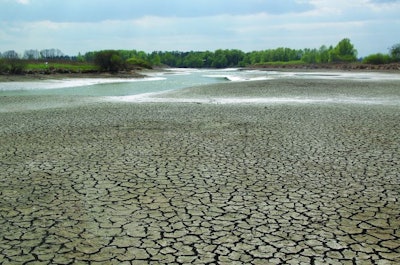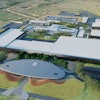
With many parts of Europe having suffered their worst droughts in 500 years, having water as the topic of the World Poultry Congress (WPC)’s opening conference, held in Paris in August this year, was perfect timing.
Water: Key for Sustainable Nutrition, organized by animal nutrition company Adisseo, argued that water was the forgotten nutrient and, opening the event, Dr. Pierre André Geraert, director of scientific marketing with Adisseo, noted that, for poultry to grow they must eat and drink. Importantly, of all livestock species, poultry would appear to be the most efficient where water use is concerned, so in a world of increasing water scarcity it is particularly important that poultry production is protected.
Dr. Pierre André Geraert, director of scientific marketing with Adisseo, noted without water there can no poultry production. Poultry, he added were efficient at using water more than other livestock species making their role in a resource challenged world more important. Courtesy Adisseo
He added that the crops that they depend upon also need water. Obvious, perhaps, but ensuring that sufficient water is available in the future will become increasingly difficult. Without water, there can be no poultry industry.
According to Dr. Frank Chmitelin, vice president of Adisseo, the poultry industry, like others, must act to use water more wisely. Fortunately, he added, reducing water consumption could be easier than reducing CO2 emissions.
He continued that the sector needed to take immediate action to reduce water losses, for example through better use of available water and irrigation, but that, longer term, there was much more that could be done to save water and to support the industry’s future.
Water Footprint
The Water Footprint (WF) offers a framework for analyzing poultry production’s impact on water resources and could help in identifying ways to reduce use.
Simply defined, the WF is the amount of water used, directly and indirectly, to produce a good or service, and shows how water flows through economies, tracing it through supply chains and trade. It can be measured for a single process, for a product, a farm, an entire company or a country, explained Dr. Thierry Caquet, scientific director for the Environment at French research institute INRAe.
Virtual water flows from one country to another can be traced. Some countries have large external footprints. Malta, Kuwait and Jordan, for example, are water scarce, while countries that are highly import dependent, for example, France, the Netherlands, Spain and the U.K., are importing water in products such as crops.
Within the poultry sector, drinking and service water, for example, contribute to the direct WF, and usually absorb blue water, i.e. water from lakes, rivers and reservoirs. The indirect WF is associated with feed, and the indirect footprint size will depend on production system, feed conversion efficiency and the feed itself, its composition and origin.

Caquet continued that the WF varies across different crops and production regions and that feed’s WF will be negatively impacted by climate change due to an increase in use of blue water.
He added that growing demand for animal products will have direct and indirect consequences on the sustainability of water use in many areas. Climate change consequences may dramatically influence water and feed availability, crop yields and the supply of high-quality fresh water to poultry farms.
Water quality
For birds to perform at their maximum genetic potential, it is not simply a question of giving them unrestricted access to water, that water must be good quality. As water becomes scarcer due to climate change, producers may need to look to new sources, which may not be ideal.
Professor Andrew Olkowski scientist emeritus at the University of Saskatchewan, Canada, noted that all drinking water from natural sources contains some level of contamination. It may be chemical or biological, but it is not simply the presence of contaminants that constitutes a problem, rather it is the quantity that determines quality and hazard risk.
When determining the risks of adverse effects associated with contaminants, he continued, three basic factors must be considered: the contaminant’s toxic potential, whether there are cumulative or synergistic effects and its concentration. Water intake also needs to be considered – the more water a bird drinks, the greater the risk.
Many drinking water pathogenic contaminants can be reasonably controlled by microfiltration or sanitation, although this is becoming more difficult due to resistance, Olkowski continued, and in many parts of the world purifying water contaminated with minerals is unaffordable.
Common mineral contaminants may affect bird health and performance in many ways. They may limit water intake, due to altering water’s palatability, and have a detrimental effect on the gut microflora, promoting the proliferation of pathogens.
Mineral contaminants can also act as laxatives and help in the performance of biofilm.

Litter issues
While concerns may be growing about whether the industry may be able to source enough quality water, issues can also arise when there is too much water in the house environment and Dr. Mario Penz global strategic account director with Cargill Animal Nutrition Brazil examined the topic of wet litter and its associated problems.
Litter is considered wet when its humidity exceeds 25%, and this happens when the amount of water added to the environment exceeds that removed. It can lead to numerous problems, including footpad dermatitis, breast blisters, ascites, environmental ammonia and CO2, flies, and bad odors. It reduces foot and breast quality and slaughter plant operational efficiency.
Much is known about wet litter, Penz continued, but this knowledge is rarely applied in the house. Its causes can vary from poor nutrition to poorly regulated water systems, but there are other factors that come into play. Faster growing birds, for example, eat more and so drink more, and their adoption has seen, for example, water consumption increase by 70% between 1985 and 2009.
However, Penz continued, it is not modern farming that is the problem, rather a lack of staff training. Workers must be properly trained if humidity in today’s large broiler houses is to be properly controlled.
Today’s birds
Dr. Alex Corzo, senior poultry nutrition specialist with breeding company Aviagen, noted that his company had identified birds that were high drinkers and low drinkers, but that selection is made closer to the mean, allowing birds to cope with changing circumstances.
Birds have good heritability for both feed and water traits, and, in the case of water, the company is able to select for certain aspects, be it consumption or efficiency.
A number of factors, however, need to be considered during selection, he continued, for example how yield and feed conversion might be maximized without raising water intake leading to wet litter, or whether selecting for lower use might impact production in another way.
He argued that the genetics industry has, in fact, been selecting for less water per unit of body weight given that 10% of water is in feed, and feed conversion ratios have improved.
Work afoot
Professor Walter Bottje at the University of Arkansas noted that increasing feed and water use efficiency will continue to be critical to meet the challenges of water scarcity in the poultry and other industries. He warned that climate impacts are already here, that they are more widespread and severe than expected and that we are locked into even worse impacts in the future.
The U.S. poultry sector is already preparing for this change. Various projects are afoot including for example, Empowering the U.S. Broiler Industry for Transformation and Sustainability, which is looking at a number of areas from divergent selection through to new ways of keeping birds cool.
He noted that one project examined sprinkling birds with water and using fans to cool birds which, compared to current cooling methods, can result in 60-70% less water being used.
Sustainable feed formulation
Water was not the only area where Adisseo had its eye on saving and making better use of resources. The company was also highlighting its feed recommendation software Nestor during the World Poultry Congress.
The Nestor service is freely available to users and allows the calculation of nutritional recommendations for poultry and swine.
Poultry feed formulation commonly calculates metabolizable energy. However, Nestor works with net energy and allows users to calculate nutritional recommendations adapted to, for example, rearing period, sex, age and breed.
Formulating to net energy reduces waste and takes away heat loss by formulating closer to a bird’s needs compared to traditional methods, making diets more sustainable.
Sustainable poultry production driving industry advances


















